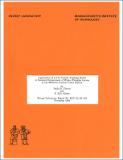Application of a 2-D particle tracking model to simulate entrainment of winter flounder larvae at the Millstone Nuclear Power Station
Author(s)
Dimou, Nadia K.; Adams, E. Eric
DownloadEL_TR_1989_002.pdf (2.973Mb)
Other Contributors
Massachusetts Institute of Technology. Energy Laboratory.
Metadata
Show full item recordAbstract
A 2-D random walk model, developed by Dimou (1989) as part of this research project, was used to simulate entrainment at the Millstone Nuclear Power Station of winter flounder larvae hatched within Niantic River. Important features of the model include larval behavior (vertical migration as a function of time of day and tidal stage) and tidal dispersion within Niantic River which was calibrated to Ketchum's (1951) Modified Tidal Prism Model. Simulations using larval hatching rates inferred from the densities of yolk-sac larvae collected within the river showed the larvae arriving significantly earlier and in smaller numbers than indicated by observations at the intake. A dye study conducted within the river and available salinity data showed that the hydrodynamic flushing time is actually less than it was simulated to be, so this does not explain the discrepancy in arrival times. However, dates of peak abundance for larvae collected at different locations within the river and Niantic Bay imply that actual larval retention times may be significantly greater than the hydrodynamic residence time, suggesting that adjustments may need to be made in the representation of larval behavior. A second dye study, conducted in the bay, showed that 15-25% of water exiting the river mouth passes through the intake--in excellent agreement with simulations. Additional factors that could help explain the small entrainment numbers and early arrival times simulated by the model are briefly discussed and include the possibilities that larval hatching rates are too low, possibly due to the method of sampling yolk-sac larvae; simulated mortality rates are too high; and larvae are being imported to the region from different spawning areas.
Date issued
1989Publisher
[Cambridge, Mass.] : Energy Laboratory, Massachusetts Institute of Technology, 1989
Series/Report no.
Energy Laboratory report (Massachusetts Institute of Technology. Energy Laboratory) no. MIT-EL 89-002.